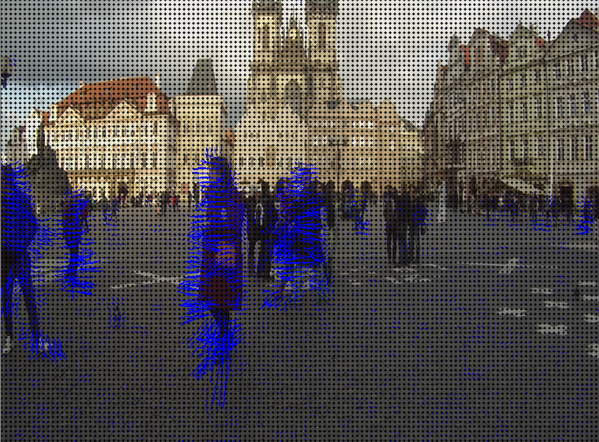- Published on
AFOptimizer - A frame optimizer for anime footages
- Authors

- Name
- Karan Prasad
- @thtskaran
AFOptimizer: Enhancing Anime Videos with Advanced Frame Analysis Techniques
As an open-source developer passionate about optimizing video content, I'm thrilled to introduce AFOptimizer—a powerful Python tool designed to enhance anime videos by removing static frames. By leveraging three sophisticated frame analysis methods, namely Frame Difference, Structural Similarity Index (SSIM), and Optical Flow, AFOptimizer streamlines the viewing experience and simplifies the editing process.
Under the Hood: How AFOptimizer Works
AFOptimizer employs a combination of computer vision techniques to detect and remove static frames from anime videos. Let's dive into the technical details of each method:
1. Frame Difference Method
The Frame Difference method is a straightforward approach to detecting motion between consecutive frames. Here's how it works:
- The method calculates the absolute difference between the current frame and the previous frame.
- A threshold is applied to the difference to determine if there is significant motion.
- If the difference exceeds the threshold, the frame is considered dynamic; otherwise, it is considered static.
The Frame Difference method is computationally efficient and works well for detecting large movements. However, it may struggle with subtle motions or changes in lighting conditions.
Here's a visual representation of the Frame Difference method:

As shown in the image, the Frame Difference method detects edges and highlights areas of motion between frames. The resulting binary image is then dilated and filled to create a mask indicating the presence of motion.
2. Structural Similarity Index (SSIM) Method
The SSIM method takes a more perceptual approach to compare the similarity between frames. It considers structural information, luminance, and contrast. The process is as follows:
- The SSIM value is calculated between the current frame and the previous frame.
- If the SSIM value exceeds a specified threshold (default: 0.9587), the frames are considered similar, and the current frame is marked as static.
- Static frames are removed from the video, resulting in a more condensed and engaging viewing experience.
SSIM is more robust than Frame Difference in handling subtle changes and is less sensitive to noise. However, it is computationally more expensive.
The SSIM method compares the structural similarity between two frames by considering three factors: luminance, contrast, and structure. It calculates a weighted combination of these factors to determine the overall similarity score. A higher SSIM value indicates greater similarity between the frames.
3. Optical Flow Method
Optical Flow is a powerful technique that estimates the motion of pixels between consecutive frames. AFOptimizer uses the Farneback algorithm for dense optical flow. Here's how it works:
- The Farneback algorithm computes a dense optical flow field, providing a motion vector for each pixel in the frame.
- The magnitude of the motion vectors is calculated to determine the amount of movement.
- If the average magnitude of motion vectors exceeds a threshold, the frame is considered dynamic; otherwise, it is considered static.
Optical Flow is highly effective in detecting detailed and subtle movements. It is particularly useful for videos where precise motion analysis is crucial. However, it is the most computationally intensive among the three methods.
The Farneback algorithm used in AFOptimizer estimates the motion vectors between consecutive frames. It assumes that the flow is smooth and approximates it using polynomial expansion. The algorithm computes the displacement of each pixel by considering the neighboring pixels and their intensities.
Here's an illustration of the optical flow vectors computed using the Farneback algorithm:

The image shows the motion vectors overlaid on the frames, indicating the direction and magnitude of pixel movement. The Farneback algorithm provides a dense optical flow field, allowing for detailed motion analysis.
Performance Comparison
AFOptimizer offers flexibility in choosing the frame analysis method based on specific requirements. Each method varies in processing time and efficiency:
- SSIM: Approximately 2.13 frames per second
- Frame Difference: Approximately 37.12 frames per second
- Optical Flow: Approximately 1.18 frames per second
Note: Performance metrics were tested on a 4vCPU, 8GB RAM replit core environment.
Getting Started with AFOptimizer
To start using AFOptimizer, follow these steps:
- Ensure you have Python and all the dependencies listed in
requirements.txtinstalled. - Run
main.pywith the desired method and video file as arguments:- For Optical Flow:
python FrameEnhancer.py -of --video=path/to/video - For Frame Difference:
python FrameEnhancer.py -fd --video=path/to/video - For SSIM:
python FrameEnhancer.py -ss --video=path/to/video --ssim_threshold=0.9587(the--ssim_thresholdflag is optional; if not used, the value will default to 0.9587)
- For Optical Flow:
AFOptimizer is an ongoing project, and contributions are welcome to enhance its functionality, refine algorithms, and add new features. If you have any questions, suggestions, or would like to contribute, please feel free to reach out to me at hello@karanprasad.com.
Let's collaborate and take anime video optimization to the next level with AFOptimizer!